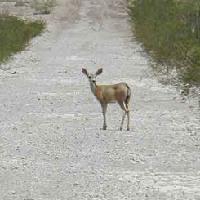Resumen
- Forage availability and quality at the Chihuahuan Desert may play an important role sustaining populations at the southern end of their current distribution. We evaluated forage availability and quality at the end of a 3-year drought at two different localities in the Chihuahuan Desert: Old Net and Pulpit, we measured plant availability and quality, diet content and calculated diet preference indices. Vegetation at Old Net consisted primarily of both succulents (47%) and trees-shrubs (42%) while Pulpit had more grasses (60%) and herbs (24%) (P < 0.005). Feces collected at the Pulpit presented a high proportion of herbs (44%), while those collected at Old Net contained more trees and shrubs (53%). Preference index suggests that mule deer prefer herbs and overlook grasses, but there is no strong selection for any particular plant. Our results suggest that forage is appropriate to sustain mule deer populations, however, we found considerable variation in both localities suggesting a patchy landscape. More information regarding forage nutritional status and diet preferences can enhance our understanding on mule deer population dynamics in the Chihuahuan Desert.
